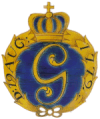 Leif Pagrotsky |
Dear friends,
Sweden and China have a long tradition of friendly and mutually beneficial contacts. This year, on May 9, Sweden and the People's Republic of China celebrated the 55th anniversary of the establishment of diplomatic relations. It is a noteworthy anniversary, not least since Sweden was the first Western country to establish relations with the PRC.
A number of Sino-Swedish cultural events will be organized throughout the year to mark the anniversary. Perhaps the largest and most prestigious of these is the large Sino-Swedish exhibition that will open at the Wu Gate at the heart of the Forbidden City in autumn.
As Sweden's Minister of Culture, and as a long-time friend and admirer of the Chinese language and culture, it brings me great pleasure to hereby introduce this unique event, sponsored by Volvo, SAS and SAS Radisson, to my Chinese friends. I hope this exhibition will help to raise awareness, both about the long history of our relations and about their peaceful and friendly nature.
It is possible to view Swedish-Chinese relations through many prisms and lenses. This exhibition uses porcelain and pottery to illustrate some of the highlights of our common history. The exhibition features porcelain that was imported from China to Sweden aboard 18th century ships, and Yangshao pottery excavated by the Swedish archaeologist Johan Gunnar Andersson in the 1920's. Andersson, supported by the Swedish crown prince at the time and numerous Chinese colleagues and supporters, was later to be known as "The Father of Chinese Archaeology."
The exhibition will also illustrate the remarkable trade contacts that were established between Sweden and China in the 18th century -- remarkable, not least since they were both so daring and adventurous and so beneficial to both parties. My own hometown Gothenburg, Sweden's second largest city, was at the heart of this commercial success story. From the 1730's and for over a hundred years thereafter, a fleet of large ships regularly left Gothenburg harbor bound for Canton (today's Guangzhou) where they, after almost a year at sea, exchanged Spanish silver for porcelain, silk, tea and other refined Chinese export items.
Very little of that porcelain, produced exclusively for European export in 18th century Jingdezhen, remains in China today. We are happy to bring some of it back, and we hope that the unique collection from six Swedish museums and a private collector featured in this exhibition will serve to highlight this little-known, but very interesting part of Chinese porcelain history. After the exhibition, Volvo will donate parts of the Chinese-Swedish antique porcelain shown in the exhibition to the permanent collection of the Palace Museum.
But that is not all. This exhibition, though remarkable in itself, is, in a way, also a foretaste of even greater things to come. Next year, a large Swedish trading ship and exact replica of an 18th century merchant vessel - the Gotheborg - will arrive in Guangzhou in the presence of our royal family and Chinese VIPs. For almost two months the ship will remain in China, before beginning its arduous one-year, return journey.
The purpose of this multi million project is, of course, to celebrate the longstanding and friendly relations between Sweden and China, and to herald a Sino-Swedish future even more peaceful and prosperous than the past.
In my own personal view, I am convinced that the best is still to come!

Leif Pagrotsky
Minister for Education, Research and Culture
The Kingdom of Sweden
